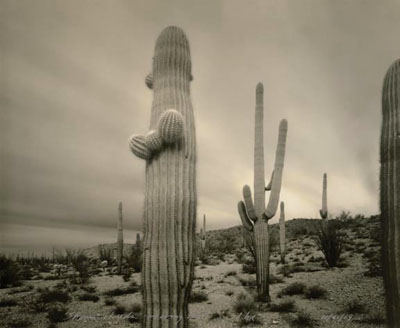
Copyright Mark Klett 2008 courtesy of Cavallo Point Lodge & Edition One Books
Time is such an elusive element, and for photographers, it is also an essential component for creating a photograph. As a result, the relevance of time to photography has been written about by John Berger, John Szarkowski, Susan Sontag, Roland Barthes, Andy Grundberg and the list goes on. Understanding time is a technical requirement to ensure the proper exposure of a piece of film or sensor to obtain the needed negative or digital file. But capturing the essence of time, as to what really is time, is a daunting task for a two-dimensional flat photograph print.
The essence of time became the quest of Mark Klett in Time Studies, published by Cavallo Point Lodge in 2008 as part of their Cavallo Point Portfolio series.
In the forward, Thom Sempere wrote “Most everyone will agree that photographs “capture time”. We live in a perpetual now that is activated constantly by a sense of past and future. Photographs thrive on this paradox – every picture was new when taken, but upon viewing, can only show us what happened then, and by implication, what has happened since. For Klett, photography becomes the best tool for examining this conundrum.”
Technically Klett creates photographic artifacts of things that do not exist in the time dimension that we know. Sontag’s slice of time is distorted by the long durations of his exposures that create images that are not those we can hold in our consciousness mind. Photographic exposures with long durations, like that of Debra Bloomfield’s oceanscapes, melds overlapping experiences into a single homogenized entity, a new kind of reality.
The use of long exposures is not a new concept in photography, and it was a fact of life for the early photographers in the 1840’s to the end of the century. Eugene Atget used his long glass plate exposures to eliminate the people from his images, to distill the scene to the buildings, structures and vegetation. But the long exposures created a dilemma for those who were attempting to photograph an “accurate” likeness of a person, or capture some faster moving event. So faster films and faster lens created sharper photographs in less time, where exposures of 1/2,000th of a second became possible. Camera designs now incorporate alarms to alert the user when the exposure is too slow, such as requiring a exposure duration of less than 1 / 30th of a second.
Klett has tapped into the earlier photographic processes to explore the element of time by extending the duration of his exposures. He effective uses two variations, an extended long exposure to constant capture the light and a series of intermittent exposures over an extended period of time. To me, the process is like creating some mysterious treasures, because you can not always foretell what the final results will appear like. With time and practice, you can kinda guess approximately what the resulting image might look like, but you can never tell with absolute certainty.
Michael Kenna will wait for an overcast sky and use the flow of water to create his plastic effects. Klett on the other hand, prefers the open sky and to tap into the elements of the sky and the universe. He documents the movement of the moon, stars, clouds and sun, to create some evidence that these things will change with time.
We see the path of the moon and sun as they change locations within the sky. Indirectly we read similar evidence by the soft blur of the shadows cast by still objects, such as a chair sitting in the sunlight on the concrete.
Klett will also turn the camera on himself as a personal exploration of his appearance over time. I find his self portrait on his 52nd birthday, which was taken over a duration of one hour to be mesmerizing. First, I could not think of holding still that long in one position that would keep the features in relative understandable definition. Perhaps unseen is a head brace or a stiff chair?
Even without the knowledge of the long duration, the soft features of this self-portrait still provide ample evidence that Klett was there. But beyond that, we still can not discern that much about him as an individual and what else he does over time; what his interests are, who are his friends, what he likes to read are or which types of movies, if any, appeal to him.
In another mysterious photograph, there is a ghostly outline of the photographer, a semi-transparent self-portrait, with the outline of trees showing through. A haunting metaphor about another kind of time, related more to our short life span compared to the longevity of trees. An alternate read is that mankind is on the go, moving from one location to another, while the dense tree has deep roots, firmly grounded to a specific location.
The photograph .357 dusk, which a silhouette of a hand hold a pistol, perhaps a .357 caliber, aligned with a ring formed by a cloud in the sky, is delightfully indicative of Keltt’s sense of humor.
All in all, I think that Klett was not attempting to provide a definitive answer to his own question, “how long is a “moment” in time, and how do photographs express duration or lengths of time”, his experimentation is a nice study in time.
Just a brief note about the book itself. I had written earlier about the Cavallo Point Lodge publishing project, which you can find here and here. For a print on demand (POD) book, I found it delightful to hold and read, with the quality of the printing appearing equivalent to many current off-set printed books. The weakness of the physical book from a structural standpoint is the glued binding of the individual sheets to the spine. It will be interesting to see how this binding holds up over time.






By Douglas Stockdale